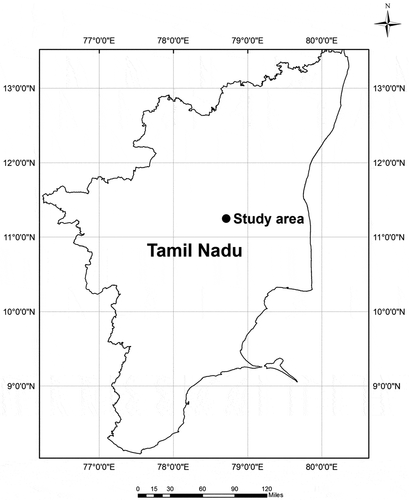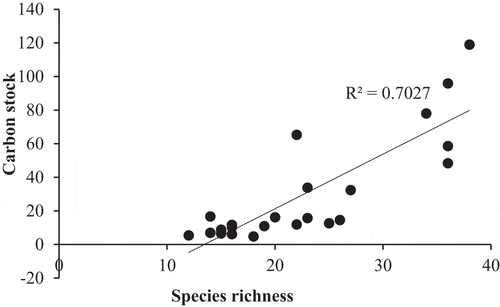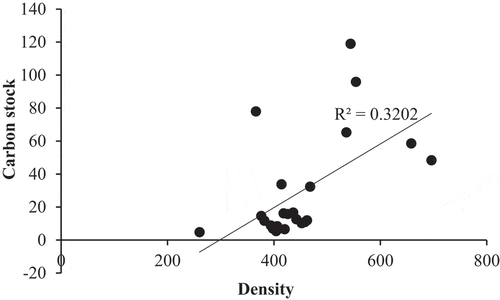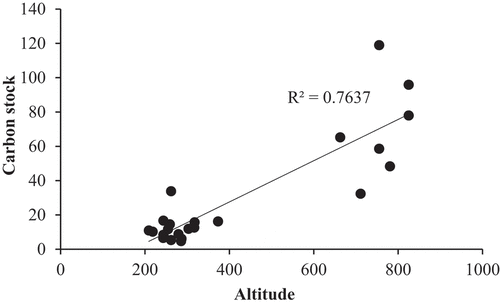ABSTRACT
The present study was carried out to understand the relationship of tree carbon stock to key factors such as species richness, density and altitude, in Pachaimalai tropical hill forest located in Tamil Nadu, India. The study area (PTHF) was parted into 24 6.25 km × 6.25 km grids, and at each grid, all live trees ≥30 cm girth at breast height were recorded from a randomly placed 0.5 ha transect. The total carbon stock estimated for the PTHF ranged from 4.79 to 119.00 t ha−1 (n = 24). The species richness, density, and altitude ranged from 12 to 38 species T−1, 260 to 696 trees ha−1 and 209 to 825 m asl, respectively. Regression analysis revealed that the total carbon stock had a significant positive relation with species richness (r2 = 0.703) as well as with altitude (r2 = 0.767), and it had no significant relation with tree density. Understanding the dynamics of tree carbon stocks in relation to key factors is of prime need for sustainable management of forest carbon sinks, and the present study provides valuable information for carbon stock management in PTHF ecosystem, and further it may help to develop testable hypotheses on other tropical forests.
Introduction
Forests are one among the biggest reservoirs of long-term storage of atmospheric carbon in mitigation of global warming and climate change (Arasa-Gisbert et al., Citation2018). However, the ever-growing population and its incessant attempts towards deforestation are posing a grave challenge to the very existence of forest ecosystems. Studies have indicated that forest ecosystems have been depleted indiscriminately in the past. Globally, major elements of the forest ecosystems are declined and degraded due to industrialization, urbanization, and anthropogenic activities. Only 7% of the earth’s total land surfaces have been covered by tropical forests but they play a significant role in the global carbon cycle (Nascimento & Laurance, Citation2002). Carbon dioxide (CO2) is one of the greenhouse gases, and its increasing concentration in the atmosphere leads to global warming and climate change. Forest ecosystems are the lifeline of world human population, which help to mitigate the ever-increasing atmospheric CO2 concentration. Globally, it is estimated that tropical deforestation annually accounts for about 1.7 billion tonnes of carbon emission into the atmosphere (The Intergovernmental Panel on Climate Change, IPCC). This rise in carbon emission is discussed promptly in the Kyoto Protocol (Salazar et al., Citation2010) regarding global warming and change in climate.
Loss of forests due to anthropogenic activities is the significant contributing factor with regard to the drastic change in climate. Hence, improving the management of forest resources to sequester CO2 is a prompt strategy to reduce greenhouse gases, which has been justified as a potential measure for climate change mitigation. Trees play major roles in carbon storage and forest ecosystem functioning (Shirima et al., Citation2015), as they trap the atmospheric carbon and convert it in to plant biomass (Ravindranath et al., Citation1997). It is important to measure tree biomass of a region to determine its carbon stock, and there are two types of assessment method, 1) direct method through destructive sampling (felling of trees) (Brown et al., Citation1989) and 2) indirect method by applying allometric equation using tree mensuration data. Indirect tree biomass assessment method is widely applied against direct method, since in contrast to direct method it is less time-consuming, less expensive, and most importantly it retains the green forest cover. Understanding the capacity of carbon sink of a particular forest is important for forest management (Malhi et al., Citation1999).
Factors like species richness, density, and altitude affects the total carbon stock in a forest besides temperature, rainfall, topography, edaphic characters, and management practices implemented (Chaturvedi & Raghubanshi, Citation2015; Chaturvedi et al., Citation2011; Malhi et al., Citation1999; Mwakisunga & Majule, Citation2012; Sharma et al., Citation2016; Shrestha & Singh, Citation2008). Hence, it is most important to understand the dynamics of carbon stocks in relation to the key factors for sustainable management of forest carbon sinks. To my knowledge, only a few studies have focused on how species richness, density, and altitude are influencing on forest carbon stocks (Aryal et al., Citation2018; Mwakisunga & Majule, Citation2012; Nakakaawa et al., Citation2010; Sharma et al., Citation2018; Shirima et al., Citation2015). Further, no similar study was undertaken in Pachaimalai tropical hill forest (PTHF) in India so far.
Hence, the present study was carried out with the main objective to understand the relationship of tree carbon stock with the key factors such as species richness, density, and altitude of PTHF located in Tamil Nadu, India, for better management of the hill forest with regard to forest carbon stock and climate change mitigation measures.
Materials and methods
PTHF is located between latitude 11º 08.5ʹ & 11º 28.5ʹ N and longitude 78º 29.0ʹ & 78º 48.5ʹ E in Tamil Nadu state of India (), and it covers about 586 km2 area with varying elevations.
It is mainly of lateritic soil, and the rocks are mostly of Charnockite, Gneiss, and varied Metamorphic rock formations in nature. The mean annual rainfall of this tropical region is 1058 mm, and the mean annual temperature is 28.3ºC.
Tree inventory was carried out by stratified random sampling method. The complete cover of PTHF was parted into 24 6.25 km × 6.25 km grids using toposheets of scale 1:50,000, and all live trees ≥30 cm girth at breast height (GBH, 1.37 m from the ground level) were recorded from a 0.5 ha transect (5 m × 1000 m) at each grid. This inventory protocol was designed as a nationwide effort (National bioresource development board, Department of Biotechnology, Government of India) to quantify plant resources of India (Pragasan & Parthasarathy, Citation2010).
A standard formula following L. A. Pragasan (Citation2016) was adopted to determine tree carbon stock (CS), as CS = (AGB + BGB) × 0.5. Here, AGB is aboveground biomass, BGB is below ground biomass, and 0.5 is the conversion factor. AGB was estimated following Chave et al. (Citation2005) as Y = 34.4703–8.0671 D + 0.6589 D2. Here Y is AGB in kg, and D is tree diameter at breast height (DBH) in cm. DBH was obtained from the tree girth measure at breast height (GBH), as DBH = π/GBH. ABG value was used to determine BGB following MacDicken (Citation1997), as BGB = AGB × (15/100).
Total carbon stock (TCS) of each transect was determined as the sum of carbon stock of each individual tree of the particular transect and it is expressed as carbon in tonne per hectare (t ha−1). Species richness of each transect was determined as the sum of different tree species present in the particular transect and it is expressed as number of species per transect (species T−1). Density of trees was determined for each transect and expressed as number of trees per hectare (trees ha−1). Altitude of each transect was determined as the mean altitude value of the readings taken at the beginning and end of the particular transect, and it is expressed as above sea level in metres (m asl). All the data are presented in mean ± standard deviation (n = 24). The level of significance in variation of values was tested by one-way analysis of variance (ANOVA). Further, regression analysis was performed between TCS with species richness, density, and altitude, to understand their relationships.
Results
TCS per transect was 29.14 ± 31.83 t ha−1 (±SD, n = 24) and it varied from as low as 4.79 t ha−1 to 119.00 t ha−1 (), revealing the heterogeneity in tree carbon stock distribution in PTHF. The tree species richness was 22.42 ± 8.20 species T−1 (±SD, n = 24) and it ranged from minimum of 12 species T−1 to maximum of 38 species T−1. The tree density was 449 ± 93.36 trees ha−1 (±SD, n = 24), and it ranged from 260 to 696 trees ha−1. The altitude of the 24 transects ranged from 209 to 825 m asl. The results of the regression analysis revealing the relationship of TCS with species richness, density and altitude are presented in , and , respectively. The regression analysis revealed that the TCS (t ha−1) had a significant positive relation with species richness (r2 = 0.703, ) as well as with altitude (r2 = 0.767, ). And, there exist, no significant relationship between TCS and tree density ().
Table 1. Mean and range values of total carbon stock, species richness, density, and altitude for the study area
Discussion
The carbon stock recorded in PTHF (29.14 ± 6.50 t ha−1) falls in the carbon stock value range of tropical forests (5.75–238.63 t ha−1) reported earlier (Greenland and Gowel Citation1970; Kira et al. Citation1974; Whitmore Citation1975 Enright Citation1979; Hozumi et al. Citation1979; FAO Citation1984–85; Rai Citation1984; Shanmughavel et al. Citation2001; Shah et al. Citation2014; Drigo et al. Citation1998; Milde et al. Citation1985; Pragasan and Karthick Citation2013; Pragasan Citation2016). Although there are several studies carried out on forest carbon stocks, only a few focused on the key factors that influence forest tree carbon stock. And, it is scanty particularly for the factors such as species richness, density, and elevation.
Understanding the relationship of tree species richness and carbon storage in forests is vital for the sustainable functioning of ecosystem services. The variation in species diversity is connected to many ecological gradients like temperature, precipitation, atmospheric pressure, solar and UV-B radiation, wind velocity that change consistently with elevations (Sharma et al., Citation2018). However, tree species richness has the potential to alter the rate of carbon sequestration and to mitigate the effects of climate change (Diaz et al., Citation2009). There are two hypothetical mechanisms; complementarity effect and selection effect hypotheses that reveal the relationship of plant species richness with biomass production (Cardinale et al., Citation2009; Tilman et al., Citation1997). Individuals in high species-rich plant communities optimize resource use by niche partitioning when compare to less species-rich communities (dominated by few plant species) where resource allocation mostly depends on the dominant species (Cardinale et al., Citation2009; Diaz et al., Citation2009). It is well known that resource supply affects biomass production (Gross & Cardinale, Citation2007) and thereby carbon storage gets affected since it is directly proportional to biomass production. A few studies suggest that increasing species richness increases carbon stock of a forest (Alavalapati et al., Citation2002; Kirby & Potvin, Citation2007). In the present study, tree carbon stock (t ha−1) increased with tree species richness (r2 = 0.703, ), which is similar to the trend observed for Bodamalai hills (r2 = 0.616, Pragasan, Citation2016) in south India. However, on the other hand, no significant relation between total tree carbon stock and species richness was reported in the earlier studies for the major hills in south India, namely Shervarayan hills (r2 = 0.198), Kolli hills (r2 = 0.301), Kalrayan hills (r2 = 0.368) and Chitteri hills (r2 = 0.422) (Pragasan, Citation2016), naturally regenerated forest stands (r2 = 0.346) and planted stands (r2 = 0.139) of secondary forests in northeastern U.S. (Urbano & Keeton, Citation2017), ago-ecosystems in south western Uganda (Nakakaawa et al., Citation2010), and for the logged and unlogged West African tropical forests (Asase et al., Citation2012).
In terms of the relationship of carbon stock and density, only a few studies have been reported worldwide. In the present study, no significant relationship (r2 = 0.320) was observed between carbon stock and density of tree species (). Earlier, similar kind of relation was reported from tropical forests in India (Pragasan, Citation2016), and a negative relation was reported for community forests (Aryal et al., Citation2018) in Nepal, while a strong positive relation (r2 = 0.689) was observed between carbon stock and density at Chitteri reserve forest (Pragasan, Citation2014) in India. Forest tree carbon stock is strongly influenced by the size of the tree species (Mwakisunga & Majule, Citation2012). It is reported that the carbon stock of a tree is directly proportional to its stem size (Shirima et al., Citation2015), and hence, total carbon stock of a forest is generally influenced by the sum of trees in larger stem size category instead of total tree density.
To discuss the role of tree size class for the present study, trees were categorized based on their GBH measures into four tree size classes viz. 30–90 cm GBH, 90–150 cm GBH, 150–210 cm GBH and >210 cm GBH classes. One way ANOVA revealed that there existed a significant variation in carbon stock (F(3,95) = 9.421, p < 0.00001) as well as density (F(3,95) = 394.538, p < 0.00001) among the four tree size classes in PTHF. In the present study larger tree size classes (90–150 cm GBH, 150–210 cm GBH and >210 cm GBH classes) had just 7% of the total tree density but they shared about 47% of the total tree carbon stock (), and this can be attributed to the low carbon stock value determined for PTHF, which is in line with earlier reports (Shirima et al., Citation2015). The results of the present study conclude that tree carbon stock (t ha−1) do not have any relationship with tree density. Further, it is evident that the density of larger tree size classes plays a vital role in total carbon stock in PTHF.
Table 2. Mean (±SD.) and percentage values of tree carbon stock (t ha−1) and density (trees ha−1), categorized by tree size class
Mean values followed by different superscripts are significantly different at the 0.05 level, respectively, for carbon stock and density.
In the present study, the tree carbon stock had a significant positive relation with altitude of forest location (r2 = 0.767, ), which is similar to the trend reported for Shervarayan hills (r2 = 0.570, Pragasan, Citation2016). In support of this, a few studies (Alves et al., Citation2010; Gairola et al., Citation2011; Sharma et al., Citation2016, Citation2018) have reported that the forest carbon storage positively correlates with increasing altitude. While, in some other cases, no relation between tree carbon stock and altitude was observed (Bodamalai hills, r2 = 0.365; Chitteri hills, r2 = 0.399; Kolli hills, r2 = 0.469) in south India (Pragasan, Citation2016). And, some have reported that tree carbon stock declines with increasing altitude (Leuschner et al., Citation2007; Moser et al., Citation2008; Zhu et al., Citation2010). In this study, the mean carbon stock value for the forests located at the low elevation (between 200 and 400 m asl) was 11.874 ± 6.843 t ha−1 (n = 17), which is almost seven times lesser than the forests at high elevation (above 400 m asl, 71.087 ± 29.330 t ha−1, n = 7) (). The t test showed that the mean carbon stock values varied significantly between the low and high elevations (t6 = −5.283, p < 0.05). In this case, the forest type plays a critical role that at low elevation deciduous forests (n = 8) and scrub forests (n = 9) exist, and at high elevation semi-evergreen forests (n = 7) exist. The mean carbon stock value for the deciduous forests and scrub forests was 15.54 ± 7.976 t ha−1 and 8.62 ± 3.549 t ha−1, respectively. And, the mean carbon stock value for the semi-evergreen forests located at high elevation was 71.09 ± 29.330, which is three times higher than the sum of the mean carbon values of deciduous and scrub forests (). One way ANOVA revealed that the mean carbon values varied significantly among the three forest types (F(2,23) = 32.356, p < 0.001).
Figure 5. Box plot showing the distribution of mean carbon stock value (t ha−1) for the low altitude (n = 17) and high altitude (n = 7) forests.
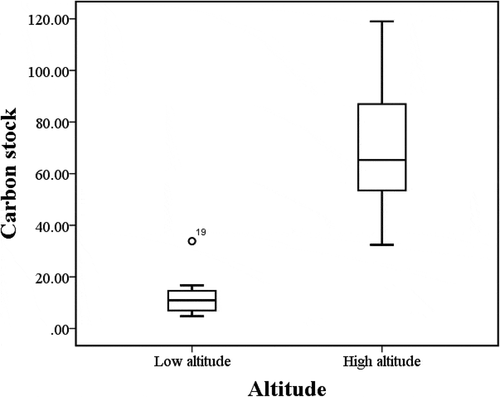
Figure 6. Box plot showing the distribution of mean carbon stock value (t ha−1) for the three forest types.

Further, the forest type at high elevation had high species richness and high density. The mean species richness value for the deciduous forests and scrub forests was 18.25 ± 3.536 species and 18.11 ± 5.036 species, and it was 32.71 ± 5.908 for the semi-evergreen forests located at high elevation. Statistically, significant variation in species richness was observed between the three forest types (ANOVA: F (2,23) = 22.016, p < 0.0001). The mean density value for the deciduous forests and scrub forests was 422.50 ± 26.376 trees ha−1 and 397.11 ± 57.229 trees ha−1, respectively. And, it was 546.00 ± 110.827 for the semi-evergreen forests located at high elevation. One way ANOVA revealed that the tree density value also varied significantly among the three forest types (F(2,23) = 9.593, p < 0.001). Here, the present study points out that the elevation gradient is considered as a key factor influencing not only the carbon stock but also species richness, density, and forest type. Usually, plants can grow and survive in a specific range of environmental conditions, but small variation in these conditions (temperature, light intensity/availability and precipitation) plays an important role in shaping up the forest structure on completely different altitudes, and that could affect the forest carbon stock.
Conclusion
The increasing concentration of atmospheric carbon leading to global warming and climate change made the world superpower nations to organize several meetings for serious discussions on reduction of carbon emissions, carbon mitigation policies such as on carbon tax and subsidy. In recent years, new projects like clean development mechanism forestry for offsetting carbon, climate action reserve, verified carbon standard, American carbon registry, etc. (Pearson et al., Citation2014) have been developed in regard to mitigating the carbon emissions. However, the atmospheric carbon concentration and its consequences are rising at an alarming speed. According to the US National Oceanography and Atmospheric Admission (US-NOAA), the earth’s CO2 concentration has increased from 412.74 ppm (during March 2019) to 414.01 ppm (during March 2020). Carbon storage in terrestrial systems is one of the natural phenomena of reduction of carbon level in the atmosphere (Shah et al., Citation2014). But, the decline in forests may have a strong negative role in achieving carbon targets, and a long-term influence and impact (Levy et al., Citation2004). Hence, proper conservation and management of forest systems is one of the most important and challenging options for the long-term storage and the reduction of the increasing concentration of the atmospheric carbon.
The results of the present study conclude that 1) the carbon stock of PTHF is within the range reported for tropical forests revealing the carbon storage potential; 2) tree carbon stock have a significant positive relationship with tree species richness, stressing the importance of increasing the species diversity of forest to increase total carbon stock; 3) tree carbon stock have no significant relation with tree density, however it is observed that the density of trees with larger stem size plays a vital role in total tree carbon stock in PTHF; 4) in case of altitude, tree carbon stock also have a significant positive relationship with altitude, revealing the fact that higher the forest altitude higher will be the total tree carbon stock in PHTF, further, it is understood that the elevation gradient is also considered as a key factor influencing on species richness, density, and forest type in PHTF.
Overall, understanding the dynamics of tree carbon stocks and its relation to key factors helps for sustainable management of carbon stock of a particular forest, and thus, the present study provides valuable information for sustainable carbon stock management in PTHF. However, from the results of this study, it is very difficult to provide a strong generalized statement regarding the relationship of carbon stock with key factors such as species richness, density, and altitude for tropical forests. Hence, it is suggested that research of this kind should be carried out in all the tropical forests of the world to frame a significant statement with regard to the relationship of carbon stocks and key factors. Finally, I hope this study would stimulate young researchers to develop testable hypotheses on tropical forests at national as well as at international levels.
Acknowledgments
I sincerely thank Dr. N.Parthasarathy, Professor of Ecology and Environmental Sciences, Pondicherry University, Puducherry, for all his support and encouragements.
Disclosure statement
No potential conflict of interest was reported by the author.
References
- Alavalapati, J. R., Stainback, G. A., & Carter, D. R. (2002). Restoration of the longleaf pine ecosystem on private lands in the US South: An ecological economic analysis. Ecological Economics, 40(3), 411–419. https://doi.org/https://doi.org/10.1016/S0921-8009(02)00012-5
- Alves, L. F., Vieira, S. A., Scaranello, M. A., Camargo, P. B., Santos, F. A., Joly, C. A., & Martinelli, L. A. (2010). Forest structure and live aboveground biomass variation along an elevational gradient of tropical Atlantic moist forest (Brazil). Forest Ecology and Management, 260(5), 679–691. https://doi.org/https://doi.org/10.1016/j.foreco.2010.05.023
- Arasa-Gisbert, R., Vayreda, J., Román-Cuesta, R. M., Villela, S. A., Mayorga, R., & Retana, J. (2018). Forest diversity plays a key role in determining the stand carbon stocks of Mexican forests. Forest Ecology and Management, 415, 160–171. https://doi.org/https://doi.org/10.1016/j.foreco.2018.02.023
- Aryal, S., Shrestha, S., Maraseni, T., Wagle, P. C., & Gaire, N. P. (2018). Carbon stock and its relationships with tree diversity and density in community forests in Nepal. International Forestry Review, 20(3), 263–273. https://doi.org/https://doi.org/10.1505/146554818824063069
- Asase, A., Asitoakor, B. K., & Ekpe, P. K. (2012). Linkages between tree diversity and carbon stocks in unlogged and logged West African tropical forests. International Journal of Biodiversity Science, Ecosystem Services & Management, 8(3), 217–230. https://doi.org/https://doi.org/10.1080/21513732.2012.707152
- Brown, S., Gillespie, A. J., & Lugo, A. E. (1989). Biomass estimation methods for tropical forests with applications to forest inventory data. Forest Science, 35(4), 881–902.
- Cardinale, B. J., Hillebrand, H., Harpole, W. S., Gross, K., & Ptacnik, R. (2009). Separating the influence of resource ‘availability’from resource ‘imbalance’on productivity–diversity relationships. Ecology Letters, 12(6), 475–487. https://doi.org/https://doi.org/10.1111/ele.2009.12.issue-6
- Chaturvedi, R. K., & Raghubanshi, A. S. (2015). Assessment of carbon density and accumulation in mono-and multi-specific stands in Teak and Sal forests of a tropical dry region in India. Forest Ecology and Management, 339, 11–21. https://doi.org/https://doi.org/10.1016/j.foreco.2014.12.002
- Chaturvedi, R. K., Raghubanshi, A. S., & Singh, J. S. (2011). Carbon density and accumulation in woody species of tropical dry forest in India. Forest Ecology and Management, 262(8), 1576–1588. https://doi.org/https://doi.org/10.1016/j.foreco.2011.07.006
- Chave, J., Andalo, C., Brown, S., Cairns, M. A., Chambers, J. Q., Eamus, D., Fromard, F., Higuchi, N., Kira, T., Lescure, J.-P., Nelson, B. W., Ogawa, H., Puig, H., Riéra, B., Yamakura, T., & Fölster, H. (2005). Tree allometry and improved estimation of carbon stocks and balance in tropical forests. Oecologia, 145(1), 87–99. https://doi.org/https://doi.org/10.1007/s00442-005-0100-x
- Diaz, S., Hector, A., & Wardle, D. A. (2009). Biodiversity in forest carbon sequestration initiatives: Not just a side benefit. Current Opinion in Environmental Sustainability, 1(1), 55–60. https://doi.org/https://doi.org/10.1016/j.cosust.2009.08.001
- Drigo, R., Shaheduzzaman, M., & Chowdhury, J. A. (1998). Inventory of forest resources of south Sylhet forest division. Assistance to the Forestry Section-phase Ii. FAO/UNDP Project BGD/85/085, Field Document, (3), Rome, Italy.
- Enright, N. J. (1979). Litter production and nutrient partitioning in rainforest near Bulolo, Papua New Guinea. Malaysian Forester, 42, 202–220.
- FAO (1984–85) Forest department of Burma. National forest survey and inventory of Burma. FO:BUR/79/001, working papers nos.5,7–12, Forest Department of Burma.
- Gairola, S., Sharma, C. M., Suyal, S., & Ghildiyal, S. K. (2011). Composition and diversity of five major forest types in moist temperate climate of the western Himalayas. Forestry Studies in China, 13(2), 139. https://doi.org/https://doi.org/10.1007/s11632-011-0207-6
- Greenland, G. J., & Gowel, J. M. L. (1970). Nutrient content of the moist tropical forests of Guana. Plant Science, 12, 154–174.
- Gross, K., & Cardinale, B. J. (2007). Does species richness drive community production or vice versa? Reconciling historical and contemporary paradigms in competitive communities. The American Naturalist, 170(2), 207–220. https://doi.org/https://doi.org/10.1086/518950
- Hozumi, K., Yoda, K., & Kira, T. (1979). Production ecology of tropical rain forests in south-western Cambodia. II. Photosynthetic production in an evergreen seasonal forest. Nature and Life in Southeast Asia, 6, 57–81.
- Kira, T., Ogawa, H., Yoda, K., & Ogina, K. (1974). Primary production by a tropical rain forest of southern Thailand. Botanical Magazine, Tokyo, 77, 428–429.
- Kirby, K. R., & Potvin, C. (2007). Variation in carbon storage among tree species: Implications for the management of a small-scale carbon sink project. Forest Ecology and Management, 246(2–3), 208–221. https://doi.org/https://doi.org/10.1016/j.foreco.2007.03.072
- Leuschner, C., Moser, G., Bertsch, C., Röderstein, M., & Hertel, D. (2007). Large altitudinal increase in tree root/shoot ratio in tropical mountain forests of Ecuador. Basic and Applied Ecology, 8(3), 219–230. https://doi.org/https://doi.org/10.1016/j.baae.2006.02.004
- Levy, P. E., Cannell, M. G. R., & Friend, A. D. (2004). Modelling the impact of future changes in climate, CO2 concentration and land use on natural ecosystems and the terrestrial carbon sink. Global Environmental Change, 14(1), 21–30. https://doi.org/https://doi.org/10.1016/j.gloenvcha.2003.10.005
- MacDicken, K. G. (1997). A guide to monitoring carbon storage in forestry and agroforestry projects.
- Malhi, Y. A., Baldocchi, D. D., & Jarvis, P. G. (1999). The carbon balance of tropical, temperate and boreal forests. Plant, Cell & Environment, 22(6), 715–740. https://doi.org/https://doi.org/10.1046/j.1365-3040.1999.00453.x
- Milde, D., Shaheduzzaman, M., & Drigo, R. (1985) The high forest in Chittagong district. Vols 1 and 2, FAO/UNDP Project BGD/79/017, field document no.3.
- Moser, G., Röderstein, M., Soethe, N., Hertel, D., & Leuschner, C. (2008). Altitudinal changes in stand structure and biomass allocation of tropical mountain forests in relation to microclimate and soil chemistry. In: Beck, E., Bendix, J., Kottke, I., Mosandl, R. (eds)Gradients in a tropical mountain ecosystem of Ecuador. Ecological Studies, 198, 229–242.
- Mwakisunga, B., & Majule, A. E. (2012). The influence of altitude and management on carbon stock quantities in Rungwe forest, southern highland of Tanzania. Open Journal of Ecology, 2(4), 214–221. https://doi.org/https://doi.org/10.4236/oje.2012.24025
- Nakakaawa, C., Aune, J., & Vedeld, P. (2010). Changes in carbon stocks and tree diversity in agro-ecosystems in south western Uganda: What role for carbon sequestration payments? New Forests, 40(1), 19–44. https://doi.org/https://doi.org/10.1007/s11056-009-9180-5
- Nascimento, H. E., & Laurance, W. F. (2002). Total aboveground biomass in central Amazonian rainforests: A landscape-scale study. Forest Ecology and Management, 168(1–3), 311–321. https://doi.org/https://doi.org/10.1016/S0378-1127(01)00749-6
- Pearson, T. R., Brown, S., Sohngen, B., Henman, J., & Ohrel, S. (2014). Transaction costs for carbon sequestration projects in the tropical forest sector. Mitigation and Adaptation Strategies for Global Change, 19(8), 1209–1222. https://doi.org/https://doi.org/10.1007/s11027-013-9469-8
- Pragasan, A. L., & Karthick, A. (2013). Carbon stock sequestered by tree plantations in university campus at Coimbatore, India. International Journal of Environmental Sciences, 3(5), 1700.
- Pragasan, L. A. (2014). Carbon stock assessment in the vegetation of the Chitteri Reserve Forest of the Eastern Ghats in India based on non-destructive method using tree inventory data. Journal of Earth Science & Climatic Change, S11:001. https://doi.org/http://dx.doi.org/10.4172/2157-7617.S11-001.
- Pragasan, L. A. (2016). Assessment of carbon stock of tree vegetation in the Kolli Hill forest located in India. Applied Ecology and Environmental Research, 14(2), 169–183. https://doi.org/https://doi.org/10.15666/aeer
- Pragasan, L. A., & Parthasarathy, N. (2010). Landscape-level tree diversity assessment in tropical forests of southern Eastern Ghats, India. Flora-Morphology, Distribution, Functional Ecology of Plants, 205(11), 728–737. https://doi.org/https://doi.org/10.1016/j.flora.2010.04.011
- Rai, S. N. (1984). Above ground biomass in tropical rain forests of Western Ghats, India. Indian Forester, 110(8), 754–764.
- Ravindranath, N. H., Somashekhar, B. S., & Gadgil, M. (1997). Carbon flow in Indian forests. Climatic Change, 35(3), 297–320. https://doi.org/https://doi.org/10.1023/A:1005303405404
- Salazar, S., Sanchez, L. E., Galindo, P., & Santa-Regina, I. (2010). Above-ground tree biomass equations and nutrient pools for a paraclimax chestnut stand and for a climax oak stand in the Sierra de Francia Mountains, Salamanca, Spain. Scientific Research and Essays, 5(11), 1294–1301.
- Shah, S., Sharma, D. P., Pala, N. A., Tripathi, P., & Kumar, M. (2014). Temporal variations in carbon stock of Pinus roxburghii Sargent forests of Himachal Pradesh, India. Journal of Mountain Science, 11(4), 959–966. https://doi.org/https://doi.org/10.1007/s11629-013-2725-2
- Shanmughavel, P., Zheng, Z., Liqing, S., & Min, C. (2001). Floristic structure and biomass distribution of a tropical seasonal rain forest in Xishuangbanna, southwest China. Biomass and Bioenergy, 21(3), 165–175. https://doi.org/https://doi.org/10.1016/S0961-9534(01)00023-X
- Sharma, C. M., Mishra, A. K., Krishan, R., Tiwari, O. P., & Rana, Y. S. (2016). Variation in vegetation composition, biomass production, and carbon storage in ridge top forests of high mountains of Garhwal Himalaya. Journal of Sustainable Forestry, 35(2), 119–132. https://doi.org/https://doi.org/10.1080/10549811.2015.1118387
- Sharma, C. M., Tiwari, O. P., Rana, Y. S., Krishan, R., & Mishra, A. K. (2018). Elevational behaviour on dominance–diversity, regeneration, biomass and carbon storage in ridge forests of Garhwal Himalaya, India. Forest Ecology and Management, 424, 105–120. https://doi.org/https://doi.org/10.1016/j.foreco.2018.04.038
- Shirima, D. D., Totland, Ø., Munishi, P. K., & Moe, S. R. (2015). Relationships between tree species richness, evenness and aboveground carbon storage in montane forests and miombo woodlands of Tanzania. Basic and Applied Ecology, 16(3), 239–249. https://doi.org/https://doi.org/10.1016/j.baae.2014.11.008
- Shrestha, B. M., & Singh, B. R. (2008). Soil and vegetation carbon pools in a mountainous watershed of Nepal. Nutrient Cycling in Agroecosystems, 81(2), 179–191. https://doi.org/https://doi.org/10.1007/s10705-007-9148-9
- Tilman, D., Lehman, C. L., & Thomson, K. T. (1997). Plant diversity and ecosystem productivity: Theoretical considerations. Proceedings of the National Academy of Sciences, 94(5), 1857–1861. https://doi.org/https://doi.org/10.1073/pnas.94.5.1857
- Urbano, A. R., & Keeton, W. S. (2017). Carbon dynamics and structural development in recovering secondary forests of the northeastern US. Forest Ecology and Management, 392, 21–35. https://doi.org/https://doi.org/10.1016/j.foreco.2017.02.037
- Whitmore, T. C. (1975). Tropical rain forests of the Far East. Clarendon Press, Oxford, and Oxford University Press.
- Zhu, J. Y., Pan, X., & Zalesny, R. S. (2010). Pretreatment of woody biomass for biofuel production: Energy efficiency, technologies, and recalcitrance. Applied Microbiology and Biotechnology, 87(3), 847–857. https://doi.org/https://doi.org/10.1007/s00253-010-2654-8

